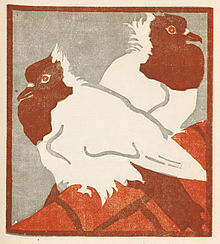Hilde Exner
Hilde Exner (born January 10, 1880 in Vienna ; † April 23, 1922 there ) was an Austrian graphic artist, sculptor and ceramicist.
Live and act
Hilde Exner came from one of the most famous academic families in old Austria. She was the daughter of Franz-Serafin Exner (1849–1926) and his first wife, Auguste Bach (1858–1883).
From 1902 to 1905 she studied painting under Kolo Moser , Friedrich Linke and Alfred Roller at the Vienna School of Applied Arts , but decided on sculpture and received formative impulses from Aristide Maillol in Paris. In her works, which are partly made of stone and bronze, partly wood and terracotta and which technically showed the full mastery of all means , the influences of George Minne , Ernst Barlach and Wilhelm Lehmbruck can be found among others . Together with her one year older cousin , Nora Exner , and Franz Fiebiger , she designed woodcuts of animals. In 1913 she exhibited six of her sculptures in the Galerie Goltz , Munich.
After the First World War, Hilde Exner moved to Salzburg with artist friends she knew from the arts and crafts school - with Emma Schlangenhausen , Helene von Taussig , Marie Cyrenius and Magda Mautner Markhof . In Salzburg, the first larger public sculpture by an artist was made by Hilde Exner: the figure of David placed on the war memorial in the cemetery in Morzg in 1920 .
During the First World War, the artist dedicated herself to caring for the wounded and in doing so took the germs of the disease that she succumbed to on April 23, 1922 . She was buried at the Sieveringen cemetery . One year after her death, Galerie Würthle , Vienna, presented an exhibition of Hilde Exner's posthumous works.
literature
- Maria Auböck (text contributions), Maria Marchetti (ed.): Vienna around 1900. Art and culture. Exhibition catalog. Brandstätter, Vienna 1985, ISBN 3-85447-097-5 , p. 502.
- Deborah R. Coen: Vienna in the Age of Uncertainty: Science, Liberalism, and Private Life. University of Chicago Press, Chicago / London 2007, ISBN 978-0-226-11172-8 .
- Andrea Elisabeth Sebald: The criminal biologist Franz Exner (1881-1947). A scientist's tightrope walk through the era of National Socialism (= Legal History Series, Volume 380). ZDB -ID 553472-0 , Lang, Frankfurt am Main, Vienna (among others) 2008, ISBN 978-3-631-57975-6 .
Remarks
- ↑ Full sister: Priska Exner (born December 29, 1877 in Vienna; † May 6, 1966 in Doorn , Netherlands), married to the surgeon Pieter Cornelis Dijkgraaf (1871–1941). See: Priska Hildegarde Dorothea Exner. In: dijkgraaf.org ( Delft Dijkgraaf Genealogy ), accessed March 19, 2012.
Web links
Individual evidence
- ↑ Ernst von Frisch: In memoriam Hilde Exner, spoken at the simple funeral ceremony at the war memorial in Morzg, on April 30, 1922. [o. O.] 1922, full text online .
- ^ A b Sebald: The criminal biologist Franz Exner , p. 29, text (family tree) online .
- ↑ a b A: Hilde Exner's estate exhibition. In: Wiener Zeitung , No. 120/1923, May 28, 1923, p. 5, bottom center. (Online at ANNO ). .
- ^ Grave site Hilde Exner , Vienna, Sieveringer Friedhof, Department 2, Group 13, No. 84.
| personal data | |
|---|---|
| SURNAME | Exner, Hilde |
| BRIEF DESCRIPTION | Austrian graphic artist, sculptor and ceramist |
| DATE OF BIRTH | January 10, 1880 |
| PLACE OF BIRTH | Vienna |
| DATE OF DEATH | April 23, 1922 |
| Place of death | Vienna |
